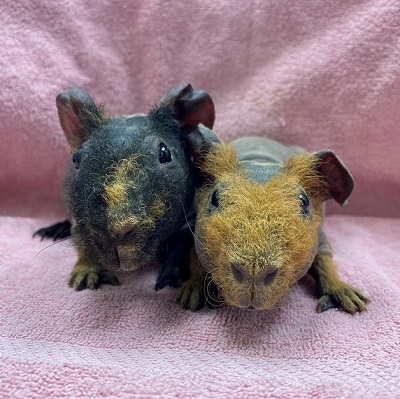
Autumn is here, September is over and our Animal of the Month, the skinny pig, is bowing out of the spotlight. We hope you enjoyed following us on Twitter @ExoticPetVets as we tweeted all month long about these animals who were Made in Canada – literally! But if you missed any of our tweets, you can always find a summary of them here for your reference. Did you know?:
- Skinny pigs are hairless guinea pigs and share the same scientific name (Cavia porcellus) with guinea pigs.
- Other than their fur – or lack thereof – there isn’t anything physically different between skinny pigs and guinea pigs. Skinny pigs are a different breed of guinea pig, not a different species, which is why they have the same scientific name.
- Skinny pigs aren’t completely hairless – they typically have hair on their muzzles, legs and feet. There are some skinny pigs who also have a bit of hair on their backs or rump.
- But there are skinny pigs who have additional hair on their bodies – ranging from on their shoulders and/or their backs to almost all over their bodies. These overly-hairy skinny pigs are commonly called “werewolf” skinny pigs.
- We usually tweet about our Animal of the Month‘s habitat in the wild, but we can’t do that for skinny pigs. Why? Because they don’t originate from the wild.
- Skinny pigs give new meaning to the term “lab animal” because in a lab is where they were created. And they were also made in Canada!
- Scientists at Montreal’s Armand Frappier Institute first identified a spontaneous genetic mutation that caused hairlessness among a colony of Hartley guinea pigs in their lab.
- They continued to breed the guinea pigs with this genetic mutation in order to create subjects for dermatological studies.
- It wasn’t until the 1990’s that skinny pigs were bred outside of the lab setting and started to become family pets.
- Skinny pigs are not the only hairless guinea pigs who were created in captivity. They may sometimes be confused with Baldwin guinea pigs, but skinny pigs are a different and distinct breed.
- The Baldwin guinea pig is the skinny pig’s American cousin. The genetic mutation creating Baldwins was discovered by California breeder Carol Miller amongst her White Crested guinea pigs.
- The difference between skinny pigs and Baldwins is that skinny pigs are mostly hairless all of their lives. Baldwins are born fully covered in hair, but they lose all of it within the first couple of months and remain hairless for the rest of their lives.
- Like guinea pigs, skinny pigs are small, stout with cylindrical bodies and short legs. Fully grown skinny pigs are typically between 8 and 10 inches (20-25 cms) in length.
- Skinny pigs have small, petal-shaped ears just like guinea pigs. But the ears on skinny pigs look larger on them because of their lack of hair.
- Even though skinny pigs lack hair, they are not all the same colour. They can have different hair colour along with different colours and patterns on their skin. Varieties of skinny pigs include “Himalayan,” “Brindle” and “Dutch.”
- In addition to not being covered in hair, skinny pigs have something else in common with humans – the need for vitamin C that they can’t produce on their own.
- Skinny pigs, like guinea pigs and primates, need to get their vitamin C from food and/or supplements in order to prevent scurvy.
- Because they lack hair, skinny pigs need to eat more than their fully-haired guinea pig counterparts for the energy they need to maintain their body temperature.
- But even though they get cold easily, skinny pigs don’t have sweat glands so they can overheat and get heat stroke just like fully-furred guinea pigs.
- Their lack of hair also makes skinny pigs vulnerable to getting sun burn.
- Skinny pigs should be kept inside and away from areas that can have temperature extremes such as vents, windows and fireplaces.
- The skinny pig lifespan tends to mirror that of guinea pigs. Skinny pigs can live about 5-6 years with proper care.
This is the second time we have featured skinny pigs as our Animal of the Month – the first time was also in the month of September! Check out our blog posts from September 2016 to see what we tweeted about skinny pigs the first time around.

